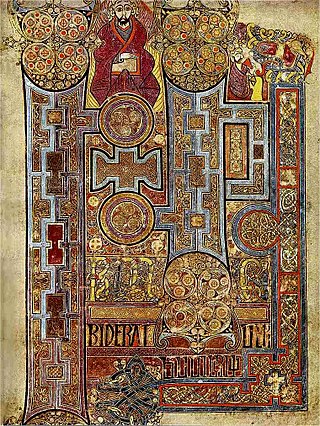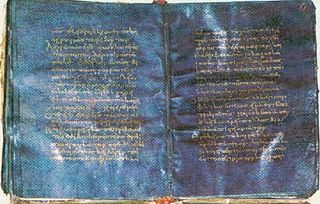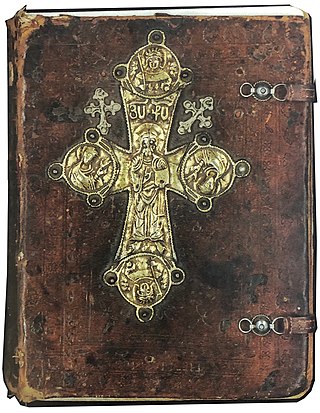
The Echmiadzin Gospels (Yerevan, Matenadaran, MS. 2374, formerly Etchmiadzin Ms. 229) is a 10th-century Armenian Gospel Book produced in 989 at the Monastery of Bgheno-Noravank in Syunik.

The Echmiadzin Gospels (Yerevan, Matenadaran, MS. 2374, formerly Etchmiadzin Ms. 229) is a 10th-century Armenian Gospel Book produced in 989 at the Monastery of Bgheno-Noravank in Syunik.
The manuscript has 232 extant leaves which measure approximately 32 by 25.5 cm. The book was made under the patronage of bishop Stepanos and written by the scribe Hovhanes. The binding of the book is made of two carved ivory plaques, probably of Byzantine manufacture of the 6th century. Bound into the book are two leaves (fols. 228–229) with miniatures dating to the late 6th—early 7th century (so-called 'Final Four Miniatures').

The art historian Carl Nordenfalk considered the Eusebian canon tables of the Echmiadzin Gospels (fols. 1–5, including the Eusebian letter) to be the best representative of the original table design (column arrangement, pattern of frame, ornament, etc.) developed in Caesarea Palaestina at the time of Eusebius (1st half of the 4th century). Taking into account the Caesarean type of the Armenian text of the Gospels, Nordenfalk concluded that the Echmiadzin Gospels were copied from a Caesarean codex equipped with the Eusebian canon tables.

The Book of Kells is an illuminated manuscript Gospel book in Latin, containing the four Gospels of the New Testament together with various prefatory texts and tables. It was created in a Columban monastery in either Ireland, Scotland or England, and may have had contributions from various Columban institutions from each of these areas. It is believed to have been created c. 800 AD. The text of the Gospels is largely drawn from the Vulgate, although it also includes several passages drawn from the earlier versions of the Bible known as the Vetus Latina. It is regarded as a masterwork of Western calligraphy and the pinnacle of Insular illumination. The manuscript takes its name from the Abbey of Kells, County Meath, which was its home for centuries.

The Rabbula Gospels, or Rabula Gospels, is a 6th-century illuminated Syriac Gospel Book. One of the finest Byzantine works produced in Asia, and one of the earliest Christian manuscripts with large miniatures, it is distinguished by the miniaturist's predilection for bright colours, movement, drama, and expressionism. Coming from a period from in which little art survived, and which saw great development in Christian iconography, the manuscript has a significant place in art history, and is very often referred to.

The London Canon Tables is a Byzantine illuminated Gospel Book fragment on vellum from the sixth or seventh century. It was possibly made in Constantinople. The fragment consists of two folios of two illuminated canon tables – of unusual construction – set beneath an ornamental arcade and the Letter by Eusebius of Caesarea which usually prefaces canon tables. The fragment is bound together with a twelfth-century Gospel Book which is thought to have belonged to one of the monasteries on Mount Athos.

British Library, Royal MS 1. B. VII, also called the Royal Athelstan Gospels, is an 8th-century Anglo-Saxon illuminated gospel book. It is closely related to the Lindisfarne Gospels, being either copied from it or from a common model. It is not as lavishly illuminated, and the decoration shows Merovingian influence. The manuscript contains the four Gospels in the Latin Vulgate translation, along with prefatory and explanatory matter. It was presented to Christ Church, Canterbury in the 920s by King Athelstan, who had recorded in a note in Old English (f.15v) that upon his accession to the throne in 925 he had freed one Eadelm and his family from slavery, the earliest recorded manumission in (post-Roman) England.

Toros Roslin ; c. 1210–1270) was the most prominent Armenian manuscript illuminator in the High Middle Ages. Roslin introduced a wider range of narrative in his iconography based on his knowledge of western European art while continuing the conventions established by his predecessors. Roslin enriched Armenian manuscript painting by introducing new artistic themes such as the Incredulity of Thomas and Passage of the Red Sea. In addition he revived the genre of royal portraits, the first Cilician royal portraits having been found in his manuscripts. His style is characterized by a delicacy of color, classical treatment of figures and their garments, an elegance of line, and an innovative iconography.

The Matenadaran, officially the Mesrop Mashtots Institute of Ancient Manuscripts, is a museum, repository of manuscripts, and a research institute in Yerevan, Armenia. It is the world's largest repository of Armenian manuscripts.

The Schuttern Gospels is an early 9th century illuminated Gospel Book that was produced at Schuttern Abbey in Baden. According to a colophon on folio 206v, the manuscript was written by the deacon Liutharius, at the order of his abbot, Bertricus.

British Library, Egerton MS 609 is a Breton Gospel Book from the late or third quarter of the ninth century. It was created in France, though the exact location is unknown. The large decorative letters which form the beginning of each Gospel are similar to the letters found in Carolingian manuscripts, but the decoration of these letters is closer to that found in insular manuscripts, such as the Book of Kells and the Lindisfarne Gospels. However, the decoration in the Breton Gospel Book is simpler and more geometric in form than that found in the Insular manuscripts. The manuscript contains the Latin text of St Jerome's letter to Pope Damasus, St. Jerome's commentary on Matthew, and the four Gospels, along with prefatory material and canon tables. This manuscript is part of the Egerton Collection in the British Library.

Eusebian canons, Eusebian sections or Eusebian apparatus, also known as Ammonian sections, are the system of dividing the four Gospels used between late Antiquity and the Middle Ages. The divisions into chapters and verses used in modern texts date only from the 13th and 16th centuries, respectively. The sections are indicated in the margin of nearly all Greek and Latin manuscripts of the Bible, and usually summarized in canon tables at the start of the Gospels. There are about 1165 sections: 355 for Matthew, 235 for Mark, 343 for Luke, and 232 for John; the numbers, however, vary slightly in different manuscripts.

The Mugni Gospel is an 11th-century Armenian Gospel Book produced in 1060. The manuscript is 42 by 32 cm and contains 301 folios. The binding of the book is made of wood, covered with red velvet and ornamented with plaques of silver and gilt. The first lines of each gospel are in gold. The first letters are lavishly decorated and painted. Actually, the book seems to be overloaded with miniatures and decorations. Saturated colours, expressive figures and fanciful architectural backdrops distinguish it from a more stylized and decorative Byzantine manner of manuscript illumination.

Armenian illuminated manuscripts, form an Armenian tradition of formally prepared documents where the text is often supplemented with flourishes such as borders and miniature illustrations. They are related to other forms of Medieval Armenian art, and to Byzantine illuminated manuscripts. The earliest surviving examples date back to the Golden Age of Armenian art and literature in the 5th century. Armenian illuminated manuscripts embody Armenian culture; they illustrate its spiritual and cultural values.

Insular art, also known as Hiberno-Saxon art, was produced in the post-Roman era of Great Britain and Ireland. The term derives from insula, the Latin term for "island"; in this period Britain and Ireland shared a largely common style different from that of the rest of Europe. Art historians usually group Insular art as part of the Migration Period art movement as well as Early Medieval Western art, and it is the combination of these two traditions that gives the style its special character.

The Gospels of St. Medard de Soissons is a 9th-century illuminated manuscript and is a product of the Court School of the Carolingian Renaissance. The codex was produced before 827 when it was given to the church of St. Medard de Soissons by Louis the Pious and his wife, Judith. It remained in Soissons until the time of the French Revolution. The book contains the Vulgate text of the four gospels, Eusebian canon tables, and other prefatory texts. The 239 surviving folios measure 362 by 267 millimeters. The twelve pages of the canon tables are decorated, in addition there are six full page miniatures and four decorative pages. The full page miniatures include a representation of the Fountain of Life based on the similar illumination in the Godescalc Evangelistary.

Minuscule 565, ε 93 (Soden), also known as the Empress Theodora's Codex, is a Greek minuscule manuscript of the New Testament, written on purple parchment, dated palaeographically to the 9th century. It was labelled by Scrivener as 473. The manuscript is lacunose. It has marginalia.
Minuscule 22, ε 288 (Soden), known also as Codex Colbertinus 2467. It is a Greek minuscule manuscript of the New Testament, written on vellum. Palaeographically it has been assigned to the 12th-century. Formerly it was assigned to the 11th-century. It has marginalia, it was adapted for liturgical use.

Minuscule 1424, δ 30 is a Greek minuscule manuscript of the New Testament, written on 337 parchment leaves. It has been dated paleographically to the 9th or 10th century).
Minuscule 826, ε218, is a 12th-century Greek minuscule manuscript of the New Testament on parchment. It has marginalia.
Minuscule 1356, ε1087, is an 11th-century Greek minuscule manuscript of the New Testament on parchment. The manuscript has complex contents.

The Zeytun Gospels of 1256 AD is an Armenian illuminated manuscript in the Armenian language by artist and ordained priest T'oros Roslin. The Zeytun Gospels consists of four tabernacles, four evangelists, four namesakes, ornaments and decorations. The manuscript's patron was Catholicos Constantine I of Bardzrberd (1221–1267) and was commissioned for his godson Levon. It was transcribed in a scriptorium at the fortress Hromklay, "the God protected castle", in Cilician Armenia. Hromklay was also known as The School of Miniature Painting at the Catholicosate. The Hromklan scriptorium was at its peak while Roslin worked there on the Zeytun Gospels. The manuscript was later reintroduced as the Zeytun Gospels named after the mountain village of Zeytun during the late Ottoman Empire.

The Emperor's Bible, also known as Codex Caesareus, Codex Caesareus Upsaliensis or the Goslar Gospels, is an 11th-century illuminated manuscript currently in Uppsala University Library, Sweden. Despite its name, it is not a Bible but a Gospel Book. The book was made in the scriptorium of Echternach Abbey, and is one of four preserved large Gospel Books made there during the 11th century. It was commissioned by Emperor Henry III and donated by him to Goslar Cathedral, where it remained until the Thirty Years' War. It was then lost for about 100 years. Its previous richly decorated cover was also lost at this time at the latest. The book later appeared again in the possession of Swedish diplomat and civil servant Gustaf Celsing the Elder. At the death of his son, it was acquired by Uppsala University.